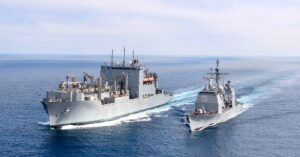
Fire Erupts Aboard Two LPG Carriers During Illegal STS Transfer Off Bangladesh
October 15, 2024
Google’s First-of-Its-Kind Nuclear Power Deal To Transform Maritime Industry’s Take On Decarbonization
October 16, 2024

The United States Navy has successfully conducted the first at-sea reload of its MK 41 Vertical Launching System (VLS) using the Transferrable Reload At-sea Method (TRAM).
The experiment took place on October 11 aboard the Ticonderoga-class cruiser USS Chosin (CG 65) off the coast of San Diego. It showed a capability that allows warships to rearm while remaining in open waters.
Sailors on the USS Chosin used TRAM, a hydraulically powered device, to load an empty missile canister into the ship’s VLS. The exercise is part of an initiative to increase operational flexibility and reduce downtime during combat.
The at-sea demonstration came after a successful land-based test in July at the Naval Surface Warfare Center, Port Hueneme Division (NSWC PHD).
The experiment allows combat ships to restock fuel, food, and missiles without returning to port. Secretary of the Navy Carlos Del Toro witnessed the test and discussed its strategic importance.
Del Toro said that this development will serve as a strong deterrent to potential enemies and is a major step forward in the Navy’s efforts to fully operationalize the system.
NSWC PHD engineers developed the TRAM prototype to make the underway replenishment (UNREP) process more efficient.
Traditionally, replenishment has focused on essential supplies like fuel and food, but TRAM includes missile reloading, allowing warships to remain combat-ready while staying closer to the action.
Rich Hadley, manager of the UNREP division at NSWC PHD, says reducing replenishment time improves a warship’s combat effectiveness. He discussed past Navy strategies and added that operating time away from the conflict was always considered a disadvantage.
During the exercise, the USS Chosin connected to the dry cargo and ammunition ship USNS Washington Chambers (T-AKE 11), transferring a missile canister to the cruiser via cables.
Sailors used the TRAM device to move the canister along rails, tilt it into position, and lower it into the onboard VLS system.
Tim Barnard, director of the NAVSEA technology office, said that once fully operational, TRAM will enable combat ships to reload their VLS systems without travelling long distances to a port.
This capability is expected to greatly enhance the Navy’s ability to deliver long-range weapons at a faster operating pace, giving it a strategic advantage over rivals.
The Navy plans to field TRAM for active deployment within the next two to three years.
Reference: US Navy
U.S. Navy Conducts First At-Sea Missile Reload Off San Diego Coast appeared first on Marine Insight – The Maritime Industry Guide
Source: Maritime Shipping News


